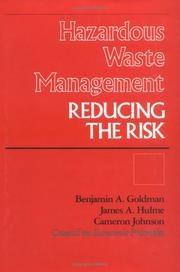| Listing 1 - 4 of 4 |
Sort by
|
Book
ISBN: 1856289818 Year: 1994 Publisher: Aldershot Avebury
Abstract | Keywords | Export | Availability | Bookmark
 Loading...
Loading...Choose an application
- Reference Manager
- EndNote
- RefWorks (Direct export to RefWorks)
Economic policy and planning (general) --- Industrial economics --- Canada
Book
Year: 2014 Publisher: Hampton, Virginia : National Aeronautics and Space Administration, Langley Research Center,
Abstract | Keywords | Export | Availability | Bookmark
 Loading...
Loading...Choose an application
- Reference Manager
- EndNote
- RefWorks (Direct export to RefWorks)


ISBN: 1610912764 9781610912761 0933280300 9780933280304 0933280319 9780933280311 Year: 1986 Publisher: Washington, DC : Island Press,
Abstract | Keywords | Export | Availability | Bookmark
 Loading...
Loading...Choose an application
- Reference Manager
- EndNote
- RefWorks (Direct export to RefWorks)
Hazardous waste management industry --- Hazardous waste sites
Book

Year: 2020 Publisher: Cambridge, Mass. National Bureau of Economic Research
Abstract | Keywords | Export | Availability | Bookmark
 Loading...
Loading...Choose an application
- Reference Manager
- EndNote
- RefWorks (Direct export to RefWorks)
We provide new evidence on the drivers of the early US coronavirus pandemic. We combine an epidemiological model of disease transmission with quasi-random variation arising from the timing of stay-at-home-orders to estimate the causal roles of policy interventions and voluntary social distancing. We then relate the residual variation in disease transmission rates to observable features of cities. We estimate significant impacts of policy and social distancing responses, but we show that the magnitude of policy effects is modest, and most social distancing is driven by voluntary responses. Moreover, we show that neither policy nor rates of voluntary social distancing explain a meaningful share of geographic variation. The most important predictors of which cities were hardest hit by the pandemic are exogenous characteristics such as population and density.
| Listing 1 - 4 of 4 |
Sort by
|

 Search
Search Feedback
Feedback About UniCat
About UniCat  Help
Help News
News